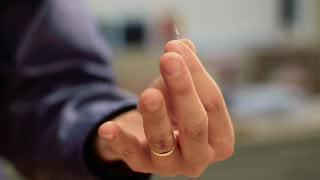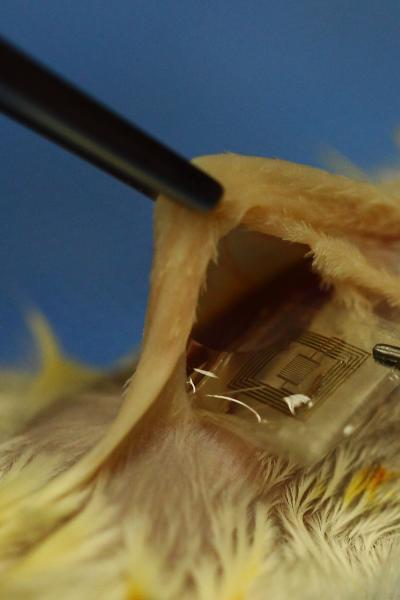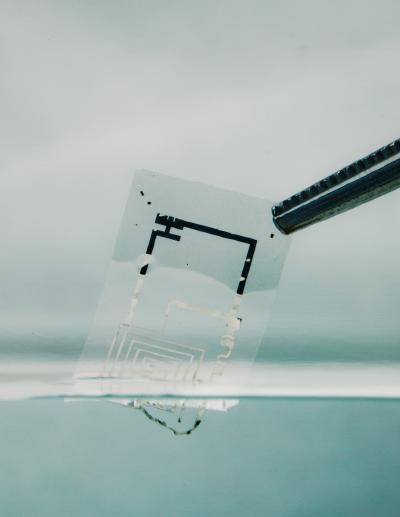"The different applications that we are considering require different operating time frames," Rogers said. "A medical implant that is designed to deal with potential infections from surgical site incisions is only needed for a couple of weeks. But for a consumer electronic device, you'd want it to stick around at least for a year or two. The ability to use materials science to engineer those time frames becomes a critical aspect in design."
Since the group uses silicon, the industry standard material for integrated circuits, they can make highly sophisticated devices in ways that exploit well-established designs by introducing just a few additional tricks in layout, manufacturing and supporting materials. As reported in the Sept. 28 issue of the journal Science, the researchers have already demonstrated several system-level devices, including a fully transient 64-pixel digital camera and an implantable applique designed to monitor and prevent bacterial infection at surgical incisions, successfully demonstrated in rats.
Next, the researchers are further refining these and other devices for specific applications, conducting more animal tests, and working with a semiconductor foundry to explore high-volume manufacturing possibilities.
"It's a new concept, so there are lots of opportunities, many of which we probably have not even identified yet" Rogers said. "We're very excited. These findings open up entirely new areas of application, and associated directions for research in electronics."
The Defense Advanced Research Projects Agency supported this work. The Tufts University team was led by Fiorenzo Omenetto; the Northwestern University team was led by Youggang Huang. Rogers is affiliated with the departments of materials science and engineering, of chemistry, of mechanical science and engineering, of bioengineering and of electrical and computer engineering, and with the Beckman Institute for Advanced Science and Technology and the Frederick Seitz Materials Research Laboratory at the U. of I.
Editor's notes: To reach John Rogers, call 217-244-4979; email jrogers@illinois.edu. The paper, "A physically transient form of silicon electronics," is available from Science at scipak@aaas.org.
A downloadable image gallery is available at http://news.illinois.edu/news/12/0924transient_electronics_images_JohnRogers.html.
SIDEBAR: Want to know more?
Transient electronics is a new class of technology whose key feature is that they can be designed to disappear completely, without a trace, in a controlled and programmable manner. Transient devices have promising applications as bioresorbable medical implants, degradable environmental monitors, compostable consumer devices and others.

A transient electronic circuit, held by professor John A. Rogers, dissolves completely as water is sprayed on it.
(Photo Credit: Anne Lukeman, University of Illinois)
The transient electronic devices demonstrated by researchers at the University of Illinois, Tufts University and Northwestern University use magnesium electrodes and interconnects, magnesium oxide gate and interlayer dielectrics, with very thin sheets of silicon, called nanomembranes, as the semiconductor. Silicon dissolves in biofluids, but at rates that are so slow that conventional silicon wafers would take hundreds of years to degrade. By contrast, nanomembranes are thin enough to dissolve in a few days or weeks, depending on their thickness, in only a few droplets of water. Yet they are thick enough to enable high-quality semiconductor devices, such as transistors, diodes and others.
Both silicon and magnesium occur naturally in the environment and have been explored for various medical implants and drug-delivery systems, although in bulk structural forms. The amount of each material in a transient electronic system is much smaller than the recommended daily allowance – the magnesium is even less than that found in a multivitamin – or even less than normal physiological levels. At the same time, it is enough for sophisticated electronics with integrated functions.
"These classes of materials have been explored for use in intravascular stents, porous bodies for drug delivery, sutures and other non-electronic medical applications," said John A. Rogers, a mechanical science and engineering professor at U. of I. who led the research. "We've figured out how to put those same materials together in ways that yield high-quality electronics, sensors and power delivery systems."
The devices are encapsulated in layers of silk, collected from silkworm cocoons, dissolved and recrystallized. By carefully controlling the crystal structure of the silk, the researchers can control the dissolution rate, so that they can tune the lifespan of a transient device for a specific application. The timescales for dissolution can range from a few minutes to days, weeks, months or potentially, years, all depending on the silk packaging.

This is a transient electronic device for monitoring and treating bacterial infection in surgical incision is implanted into a rat.
(Photo Credit: Beckman Institute, University of Illinois and Tufts University)

A biodegradable integrated circuit during dissolution in water. This demonstration system includes transistors, diodes, inductors and capacitors, composed of magnesium electrodes/interconnects, magnesium oxide gate/interlayer dielectrics, and silicon nanomembrane semiconductors, all on a thin film of silk. The device is approximately one inch long.
(Photo Credit: Beckman Institute, University of Illinois and Tufts University)